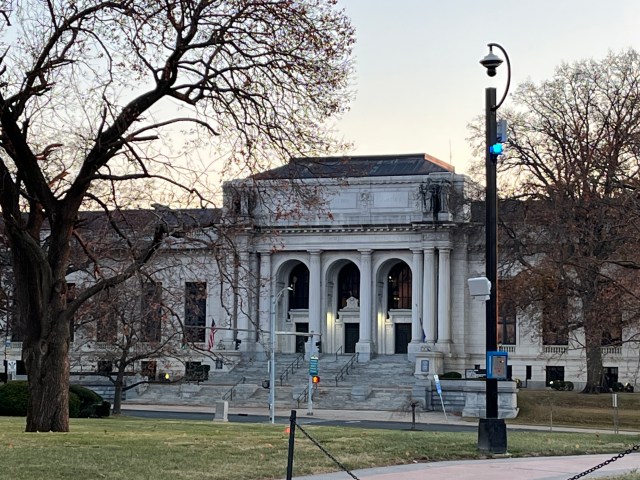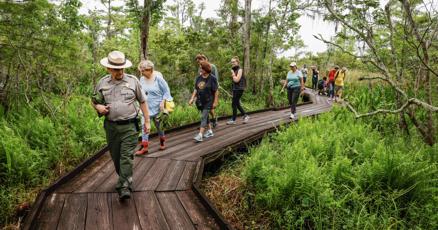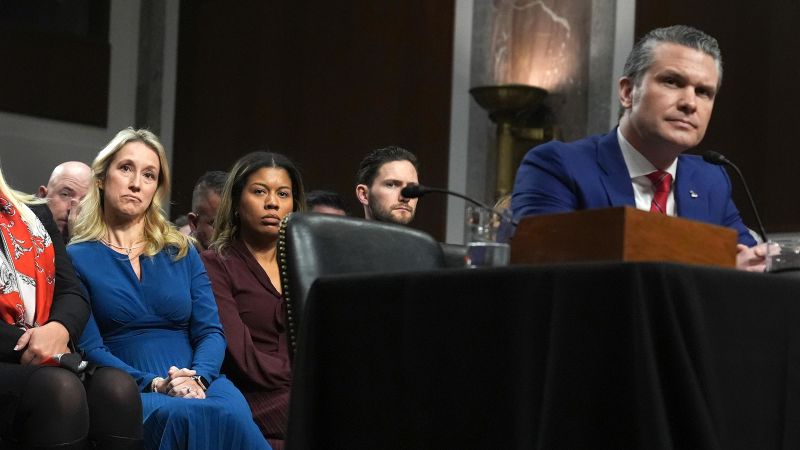Trump's Green Missteps: How Environmental Choices Derail Latin American Diplomacy
Environment
2025-03-03 12:00:00
Latin America's Diplomatic Landscape: Challenges and Tensions in US Foreign Policy The relationship between the United States and Latin America continues to evolve, marked by complex diplomatic interactions and policy shifts. Recent developments have highlighted significant challenges, particularly in areas of aid and environmental discourse. The current US administration's approach to Latin America has been characterized by nuanced yet controversial strategies. Of particular concern are the recent decisions to suspend critical aid programs and effectively silence official discussions surrounding climate change. These actions have raised eyebrows among regional experts and diplomats who view such moves as potentially destabilizing. While the administration maintains its strategic interests in the region, the suspension of vital assistance and the suppression of climate-related dialogue represent a notable departure from previous diplomatic engagement models. Such approaches risk undermining long-standing collaborative efforts and potentially weakening diplomatic ties with Latin American nations. The implications of these policy choices extend beyond immediate diplomatic circles, potentially impacting economic development, environmental cooperation, and regional stability. Stakeholders are closely monitoring how these decisions might reshape the geopolitical dynamics between the United States and Latin American countries. As the situation continues to unfold, the international community remains attentive to the potential long-term consequences of these diplomatic maneuvers. MORE...
Green Goals in Jeopardy: EU's Climate Targets Slip Away
Environment
2025-03-03 11:21:06
The European Union faces significant challenges in meeting its ambitious 2030 environmental targets, according to a comprehensive report released by the European Environmental Agency. While the EU has made notable strides in several key areas, including reducing air pollution, minimizing pesticide usage, and decreasing marine plastic waste, experts warn that more aggressive measures are urgently needed. The report highlights critical areas requiring immediate attention, such as noise pollution, microplastic contamination, nutrient pollution, and overall waste generation. Despite previous environmental initiatives, these sectors continue to pose substantial challenges for policymakers and environmental advocates. European citizens are increasingly vocal about their desire for cleaner environments, demanding pristine air, water, and soil, along with safer chemical practices. The report underscores the growing gap between current progress and the ambitious targets set for 2030, emphasizing the need for comprehensive and decisive environmental strategies. Environmental experts stress that while incremental improvements have been observed, "much stronger action is necessary" to effectively address the complex ecological challenges facing the continent. The findings serve as a critical wake-up call for EU member states to accelerate their environmental protection efforts and implement more robust sustainability measures. MORE...
Neighborhood Showdown: AI Research Center Sparks Heated Tensions in Baltimore
Environment
2025-03-03 11:00:35
Residents of the Remington neighborhood are expressing growing concerns about the potential impacts of the new Data Science and AI Institute building. Local community members fear the development could bring significant disruptions to their quiet residential area, including increased traffic congestion, elevated noise levels, and potential ecological disturbances. Neighbors are particularly worried about the potential transformation of their peaceful community. The proposed institute threatens to introduce a surge of vehicle traffic, create ongoing construction noise, and potentially damage the local environmental ecosystem. Residents are anxious about how the new development might alter the character and tranquility of their established neighborhood. Community leaders and local homeowners are actively discussing strategies to address their concerns, seeking ways to mitigate potential negative consequences of the institute's construction and future operations. They are calling for comprehensive environmental impact studies and traffic management plans to protect the neighborhood's quality of life. As discussions continue, the tension between technological progress and community preservation remains a central theme, highlighting the delicate balance between urban development and neighborhood preservation. MORE...
Green Crisis: Belgium's Hidden Environmental Nightmare Exposed
Environment
2025-03-03 10:50:11
In a pivotal moment for environmental policy, European Commissioner Jessika Roswall took center stage at the EU headquarters in Brussels on Monday, March 3, 2025. During a compelling media conference, Roswall outlined the European Union's ambitious zero-pollution targets for 2030, signaling a transformative approach to environmental sustainability. The Commissioner, responsible for Environment, Water Resilience, and Competitive Circular Economy, delivered a passionate address that underscored the EU's commitment to combating environmental challenges. Her presentation highlighted the critical strategies and innovative approaches designed to dramatically reduce pollution across multiple sectors. Journalists and environmental experts gathered to hear Roswall's comprehensive vision, which promises to reshape Europe's environmental landscape. The conference marks a significant milestone in the EU's ongoing efforts to create a more sustainable and resilient future for the continent and beyond. As global attention increasingly focuses on climate action, Roswall's presentation represents a crucial step in the EU's proactive approach to environmental protection and economic transformation. MORE...
Green Misstep: Why Hartford's Latest Environmental Plan Falls Short
Environment
2025-03-03 10:00:46
In a critical moment of fiscal responsibility, the Department of Administrative Services (DAS) must take a strategic approach to prevent potential financial missteps. The current update proposal risks becoming a shortsighted investment that could ultimately burden taxpayers with unnecessary future expenses. This is a pivotal opportunity to reassess and redirect our approach, ensuring a more sustainable and cost-effective solution. By carefully evaluating the long-term implications of this update, DAS has the chance to demonstrate true fiscal wisdom. Rather than rushing into a quick fix that may require costly corrections down the line, the department should prioritize a comprehensive and forward-thinking strategy that protects both public resources and taxpayer interests. Now is the moment to chart a more intelligent course—one that balances immediate needs with future financial prudence. A thoughtful, strategic approach will not only save money but also set a precedent for responsible government spending. MORE...
Green Warriors Rising: How Filipino Activists Are Battling Environmental Destruction
Environment
2025-03-03 10:00:00
In the lush, verdant landscapes of the Philippines, a powerful movement is taking root. Indigenous youth and dedicated forest rangers are rising up, challenging long-standing marginalization and fighting for their fundamental right to protect and manage their ancestral lands. These passionate defenders are no longer content to remain silent spectators in the conservation of their traditional territories. With unwavering determination, they are demanding a seat at the table, insisting that their voices, knowledge, and deep-rooted connection to the land be recognized and respected. For generations, indigenous communities have been systematically excluded from environmental decision-making processes. Now, a new generation of activists is breaking through these barriers, bringing fresh perspectives and traditional ecological wisdom to the forefront of forest conservation efforts. Young indigenous leaders are leveraging education, technology, and grassroots organizing to amplify their message. They are not just protecting forests; they are defending their cultural heritage, biodiversity, and the very essence of their community's survival. Forest rangers from these communities are on the front lines, combining traditional monitoring techniques with modern conservation strategies. Their intimate knowledge of the landscape, passed down through generations, provides an invaluable approach to sustainable land management that goes far beyond conventional methods. This movement represents more than just environmental protection—it's a powerful assertion of indigenous rights, cultural identity, and self-determination. By challenging exclusionary practices and demanding meaningful participation, these young activists are reshaping the narrative of conservation in the Philippines. MORE...
Green Revolution: EU Races Towards 2030 Zero-Pollution Goals, But Challenges Loom Large
Environment
2025-03-03 08:30:00
In a landmark assessment of environmental progress, the European Commission and the European Environment Agency (EEA) have unveiled their latest Zero Pollution Monitoring and Outlook report, shedding light on the EU's ambitious journey towards cleaner, healthier ecosystems by 2030. Alongside the zero pollution report, the Commission has also released its fourth Clean Air Outlook report, offering a comprehensive snapshot of environmental achievements and challenges. While the findings reveal significant strides in reducing air pollution, pesticide use, and marine plastic litter, they also sound a cautionary note about persistent environmental threats. The reports highlight notable successes in EU environmental policies, demonstrating tangible reductions in several key pollution areas. However, they also underscore the urgent need for continued action, particularly in addressing critical challenges such as: • Excessive noise pollution • Microplastic contamination • Nutrient pollution • Escalating waste generation Despite progress, the message is clear: the EU must intensify its efforts to create a truly sustainable and pollution-free environment for future generations. MORE...
Green Revolution: Rajasthan's Bold Environmental Shield Takes Shape
Environment
2025-03-03 07:22:18
In a proactive stance towards environmental conservation, Rajasthan Chief Minister Bhajanlal Sharma highlighted the state government's comprehensive efforts to enhance ecological sustainability. During a press conference on Monday, Sharma emphasized the collaborative approach between the central and state governments in implementing strategic measures to purify the atmosphere and protect the environment. The Chief Minister underscored the importance of comprehensive environmental protection strategies, signaling a committed approach to addressing ecological challenges. By integrating both state and national-level initiatives, Rajasthan is demonstrating its dedication to creating a cleaner, greener future for its citizens. These environmental protection efforts are expected to not only improve air quality but also contribute to long-term ecological balance and sustainable development in the region. Sharma's announcement reflects a growing recognition of the critical need for systematic environmental conservation measures. MORE...
Ocean's Mysterious Messengers: Are Deep-Sea Creatures Signaling an Ecological Alarm?
Environment
2025-03-03 07:17:00
Marine Mysteries: Unusual Ocean Phenomena Signal Potential Environmental Changes Recent marine observations have sparked scientific curiosity as rare and unexpected oceanic events continue to puzzle researchers. Extraordinary sightings of deep-sea creatures like oarfish surfacing near coastlines, unprecedented mass whale strandings, and anglerfish appearing in shallow waters are raising critical questions about potential environmental transformations. These unusual occurrences are not merely isolated incidents but may represent significant ecological shifts. Marine biologists and oceanographers are closely monitoring these phenomena, suggesting they could be early indicators of broader changes in ocean ecosystems. The sudden appearance of typically deep-dwelling species in unexpected locations might signal disruptions in marine habitats, ocean temperatures, or food chain dynamics. Oarfish, known for their serpentine appearance and typically residing in profound ocean depths, have been spotted closer to shorelines with increasing frequency. Similarly, mass whale strandings have become more common, potentially indicating navigational challenges or underlying environmental stressors affecting marine life. Scientists emphasize the importance of continued research and observation to understand these intriguing marine events and their potential implications for global ocean health and climate systems. MORE...
Climate Crisis Deepens: Indonesia's Flawed Plan Threatens People and Ecosystems
Environment
2025-03-03 05:36:36
Indonesia's Climate Strategy Falls Short: A Critical Look at Just Transition Indonesia's recent climate policy documents have revealed a significant shortcoming in addressing the critical social and environmental dimensions essential for a truly equitable climate transformation. While the nation has made strides in climate planning, the current approach fails to comprehensively integrate the human and ecological elements that are crucial for a meaningful and just transition. The documents demonstrate a narrow focus that overlooks the complex interconnections between environmental sustainability, social justice, and economic adaptation. By neglecting the broader context of climate change impacts, Indonesia risks creating policy frameworks that may inadvertently marginalize vulnerable communities and ecological systems. A truly effective climate strategy must go beyond technical targets and emissions reductions. It requires a holistic approach that centers the experiences of local communities, protects workers in transitioning industries, and ensures that environmental protection and social equity are not treated as competing priorities, but as interconnected goals. As Indonesia continues to develop its climate response, policymakers must prioritize inclusive dialogue, community engagement, and a nuanced understanding of the social and environmental challenges that accompard the urgent need for climate action. MORE...
- 1
- 2
- 3
- 4
- 5
- 6
- 7
- 8
- 9
- 10
- 11
- 12
- 13
- 14
- 15
- 16
- 17
- 18
- 19
- 20
- 21
- 22
- 23
- 24
- 25
- 26
- 27
- 28
- 29
- 30
- 31
- 32
- 33
- 34
- 35
- 36
- 37
- 38
- 39
- 40
- 41
- 42
- 43
- 44
- 45
- 46
- 47
- 48
- 49
- 50
- 51
- 52
- 53
- 54
- 55
- 56
- 57
- 58
- 59
- 60
- 61
- 62
- 63
- 64
- 65
- 66
- 67
- 68
- 69
- 70
- 71
- 72
- 73
- 74
- 75
- 76
- 77
- 78
- 79
- 80
- 81
- 82
- 83
- 84
- 85
- 86
- 87
- 88
- 89
- 90
- 91
- 92
- 93
- 94
- 95
- 96
- 97
- 98
- 99
- 100
- 101
- 102
- 103
- 104
- 105
- 106
- 107
- 108
- 109
- 110
- 111
- 112
- 113
- 114
- 115
- 116
- 117
- 118
- 119
- 120
- 121
- 122
- 123
- 124
- 125
- 126
- 127
- 128
- 129
- 130
- 131
- 132
- 133
- 134
- 135
- 136
- 137
- 138
- 139
- 140
- 141
- 142
- 143
- 144
- 145
- 146
- 147
- 148
- 149
- 150
- 151
- 152
- 153
- 154
- 155
- 156
- 157
- 158
- 159
- 160
- 161
- 162
- 163
- 164
- 165
- 166
- 167
- 168
- 169
- 170
- 171
- 172
- 173
- 174
- 175
- 176
- 177
- 178
- 179
- 180
- 181
- 182
- 183
- 184
- 185
- 186
- 187
- 188
- 189
- 190
- 191
- 192
- 193
- 194
- 195
- 196
- 197
- 198
- 199
- 200
- 201
- 202
- 203
- 204
- 205
- 206
- 207
- 208
- 209
- 210
- 211
- 212
- 213
- 214
- 215













